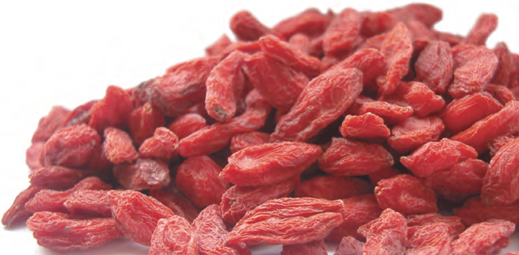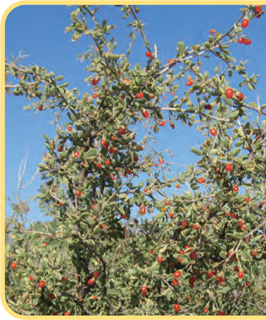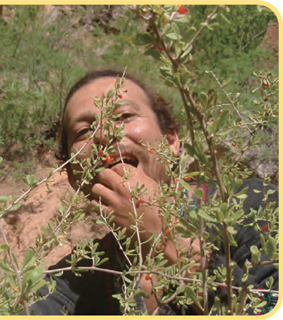
Latin Names:
Major Asian varieties: Lycium barbarum, Lycium chinensis
Major American varieties: Lycium andersonii, Lycium berlandieri, Lycium brevipes, Lycium californicum, Lycium carolinianum, Lycium cooperi, Lycium exsertum, Lycium fremontii, Lycium halimifolium, Lycium macrodon, Lycium pallidum, Lycium parishii, Lycium puberlum, Lycium torreyi (Lycium is also spelled Lyceum, depending on the reference text or web site)
Common Names:
Goji Berry, Wolfberry, Boxthorn, Matrimony Vine, Desert Thorn
Superfood Type:
Berry (fruit)

The following parts of the goji berry bush have also been used in herbal preparations or as food:
Seeds
Flowers
Leaves
Roots
Goji berries grow on a bush that develops like a vine when grown in the shade. At the very largest, the goji bush will grow six feet tall and will have a radius of around three feet. The ovate leaves range in length from half an inch to four inches depending on location and variety. Red striations are sometimes seen in the bark of the plant. Although not specifically a thorny plant like a rose, some American goji berry varieties can develop some thornlike stems. During the nonflowering seasons (summer, fall, and winter), the goji berry bush may lose some or all of its leaves, which makes it more difficult to recognize. In spring, however, the leaves fill out beautifully and pale-white to purple flowers enrich the plant, usually beginning in March in the northern hemisphere. Following the flower pollination, fruit berries will soon follow. Goji berries range in color from pale yellow to dark sunfire orange to deep red. Sometimes the raisin-sized goji berries are oblong, like footballs. I have even seen goji berries that are shaped like small peppers. Often the berries are entirely spherical.
There are an estimated eighty-five species of goji berry in Asia and fifteen species in North and Central America. It is possible, based on this geographic dispersion, that the goji berry was brought to North America by groups who migrated from Asia, either by boat or across the Bering Land Bridge.
The goji berries of Asia and America are remarkably similar. The history of the Asian varieties is better documented, researched, and consecrated in legend and lore, but both the Asian and American goji berry varieties deserve special attention because their histories and health-giving properties are so rich.
All goji berries that I have studied and grown are remarkably adaptable. The goji berries grow as wonderfully in harsh, dry deserts as they do in the tropics. Goji berries also tolerate freezing winters and have been recorded to grow well in such places as Nova Scotia and British Columbia. Perhaps most interesting is that goji berries can handle daily swings in temperature as great as 40 degrees Fahrenheit.
The goji berry was categorized under the Linnaean Latin categorization system under the genus Lycium (or Lyceum). From its Greek root, the word Lyceum means “school of learning.” And that is what the masters of Chinese herbalism believed the goji berry could provide. Legend has it that one can tune into a pharmacopeia of herbal data contained within the plant simply by eating goji berries. Further, some believe that if one studies, grows, and eats the goji berry, it is able to teach you the fundamental principles of Chinese herbalism.

Because of the goji berry’s extraordinary nutrient value, rich red-orange color, and pleasant, full-bodied taste, the Chinese, Mongolian, and Tibetan peoples have been growing the alkaline goji berry plant for an estimated five thousand years. To preserve the fruit, it is often dried until similar to a dry raisin in texture.
In Chinese tradition, the spirit or deva of the goji bush is often represented as a young, virile female who is—interestingly—not of Asian ethnicity. Ningxia Province in China, where goji berries are primarily grown, has more centenarians than the rest of the country, and the residents of the province age more gracefully. They are more active, healthy, and vibrant than elderly people in Western countries. Of course, goji berries are a key ingredient in their healthy diet. The Chinese hold a strong belief that this fruit can significantly extend life.
The famed Li Qing Yuen, whom legend has it popularized both goji berries and ginseng, and is said to have lived to the age of 252 years (1678–1930), consumed goji berries daily. The life of Li Qing Yuen is the most documented case of extreme longevity known. The legend of Li Qing Yuen says that when Li was eleven years old he met three Taoist sages who were purported to be over three hundred years old. They taught Li about spring water and the science and fine art of longevity, proper diet, and herbalism. Later in his life, at the age of fifty, he was said to have met another Taoist sage who told Li he was five hundred years old. When Li inquired about the secret of his extreme longevity, the sage taught him to consume a goji berry soup each day. Li Qing Yuen is said to have given a lecture at the University of Beijing at the age of two hundred. When the emperor of China discovered such a long-lived person within the empire, he invited Li to the royal court. Within a few months of living in Beijing, Li Qing Yuen was dead, apparently either from eating the processed food provided by the royal kitchen or from exposure to the toxicity of the city.
Even if Li Qing Yuen’s longevity is just a myth, it does demonstrate a recognized relationship in the culture between the goji berry and longevity.
By the way, as far as I have been able to uncover from studying the life of Li Qing Yuen for over a decade, his daily tea consisted of goji berries, ginseng, and reishi mushrooms. You can make this tea at home and it is delightful. I often use wild reishi mushrooms that I pick from the forest behind my home.
The famed elixir of longevity in Chinese medicine is supposed to have consisted of goji berries and flowers picked in spring, leaves picked in the spring or summer, and the root picked in autumn. All of these mixed together into a super tonic were said to keep one young indefinitely.
Goji berries are also grown in Tibet and have been recognized by the Tibetan School of Medicine in Lhasa as a superfood for twenty-five hundred years. The Lycium barbarum variety of the goji berry is said to have originally been from Tibet. Only the goji berries packed under the Tibet Authentic brand are actually grown in Tibet. Other advertised “Tibetan” goji berries are grown in Mongolia or China.
American goji berry varieties are concentrated mostly in the desert Southwest of the United States (Arizona, California, Colorado, Utah, New Mexico, Texas) with some species also present in the western deserts of Mexico and South America. The goji berry was an important food source for nearly all Native American tribes in the desert Southwest including the Hopi, Apache, Supai, Hohokam, Pima, Anasazi, Navajo, Zuni, and many others.
The great Apache, Geronimo, was born in one of the most dense, wild goji-berry regions of America. The Apaches subsisted on goji berries, corn, saguaro cactus fruit, barrel cactus fruit, red-seeded watermelons, wild walnuts, wild apples, wild grapes, wild game and fish, green herbs, some domesticated beans, herbs such as devil’s claw, and spring water. The tribe was known to possess astounding strength, agility, longevity, and survival skills.
The goji berry is an “adaptogen,” a term used in the world of medicinal plants to describe a substance with a combination of therapeutic actions on the human body. An adaptogen invigorates and strengthens the system while helping the body to deal more easily with stress by supporting the adrenal glands. In the Chinese medicinal system, the goji berry is known to harmonize and increase the jing energy of the adrenals and kidneys, resulting in enhanced stamina, strength, longevity, and sexual energy.
Overall, goji berries boost immune function, increase alkalinity andvitality, provide liver protection, improve eyesight and blood quality, deliver anti-aging compounds, and possess a number of additional outstanding qualities.
Although often recommended for such chronic conditions as liver or kidney disorders, weak joints and legs, lower back problems, dizziness and tinnitus, headaches, insomnia, hypertension, tuberculosis, and impotence, goji berries are not used for treating illness or poor health as such. Their main health benefit is to nourish the body—to support the body in healing itself by providing a startling array of extraordinary nutrients.
Goji berries are perhaps the most nutritionally rich berry-fruit on the planet. They taste delicious and are well-balanced for nearly all body types, blood types, and metabolisms. They are a complete protein source, and contain nineteen different amino acids (on par with bee pollen) and all eight essential amino acids (such as adrenal-supporting phenylalanine and serotonin-building tryptophan). Goji berries can contain twenty-one or more trace minerals (the main ones being zinc, iron, copper, calcium, germanium, selenium, and phosphorus) as well as vitamins B1, B2, B6, and vitamin E.
Contrary to Internet marketing claims, the dried goji berry is not a rich source of vitamin C. I have had different batches of dried organic goji berries tested three times for vitamin C by reputable labs and found that the content was nearly zero. At this time I have been unable to find any laboratory reports indicating that either dried or fresh goji berries contain a significant quantity of vitamin C.
Depending on variety and growing conditions, mature goji berries can contain about 11 mg of blood-building iron per 100 grams (2–3 handfuls) as well as beta-sitosterol (an anti-inflammatory agent), linoleic acid (an essential fatty acid), anti-aging sesquiterpenoids (cyperone, solavetivone), liver-healing betaine (0.1 percent), and antioxidant tetraterpenoids (zeaxanthin, physalin). Goji berries are some of the highest antioxidant-containing foods in the world. They typically contain two to four times the amount of antioxidants found in blueberries.
Goji berries contain long-chain sugars known as polysaccharides that fortify the immune system. The short- and long-chain sugars that the goji berry contains include: D-rhamnose, D-xylose, D-arabinose, D-fucose, D-glucose, and D-galactose. About 36 percent of the sugars found in domesticated goji berries are the interesting long-chain sugar polysaccharides. The percentage is greater in wild goji-berry varieties.
As we age, we produce less and less Human Growth Hormone (HGH). Decreasing levels of HGH have been linked to symptoms of aging. Goji berries are the only food known to help stimulate the human body to produce more HGH naturally. This factor alone makes the goji berry perhaps the world’s greatest anti-aging superfood.
The great macrobiotic nutritionist Michio Kushi used to say, “Eat according to your purpose.” If at least part of your purpose is longevity and vitality, then the goji berry is the superfood for you. Evidence from every direction indicates that the goji berry is the leading longevity superfood in the world. It has been nicknamed “the longevity fruit.” Researchers who study medicinal plants have identified a variety of nutrients in the goji berry that may help people enjoy longer and healthier lives.

A seventy-year-old produces only one-tenth of the amount of Human Growth Hormone (HGH) generated by a twenty-year-old. This decline parallels physical deterioration, such as lower levels of energy, muscle wasting, and a tendency to store more body fat. Boosting the natural production of growth hormone helps us feel, look, and function like a more youthful person. Goji berries help our bodies do this in several interesting ways.
There is evidence that goji berries increase longevity because they are high in sesquiterpenoids. Sesquiterpenoids have anti-inflammatory properties. They stimulate the pituitary and pineal glands thus increasing the glandular production of HGH. Human Growth Hormone is a master hormone that influences the level of all hormones in the body. Remember, as we age, HGH decreases. In order to achieve great longevity, we have to maintain HGH production. The goji berry is the only food known that is a confirmed secretagogue (a secretagogue is a compound that stimulates HGH).

The presence of certain amino acids in the goji berry may also promote the production of HGH. The goji berry is a rich source of l-glutamine and l-arginine. These two amino acids work together to boost growth hormone levels in order to revitalize one’s appearance and metabolism.
In Asia, goji berries are traditionally regarded as a strong sexual tonic. In addition, goji berries act as a general tonic to improve overall stamina, mood, and well-being while decreasing the impact of stress on our bodies. All of these benefits together are conducive to a healthier, richer sex life. Diminished sexual function is not an inevitable part of aging. A lower sex drive in both men and women can be associated with a decreased production of testosterone. Goji berries help by increasing HGH production, which then facilitates an increase in testosterone production.
Antioxidants protect our DNA from free radical and radiation damage. DNA damage opens the door to every imaginable illness and accelerates aging. Over the course of time, our DNA is damaged by free radicals, generated as a byproduct of normal metabolism, and by exposure to toxins and radiation.
Although our bodies are equipped to continually repair themselves, they can become overwhelmed by too many free radicals, especially as we age. This results in the premature death of healthy cells, which may contribute to a variety of degenerative diseases and to the accelerated development of mutated cells that can lead to cancer—unless antioxidants counter the onslaught.
The goji berry is nature’s richest food source of antioxidant carotenoids (such as beta-carotene—goji berries contain more beta-carotene than carrots). Carotenoids are natural fat-soluble antioxidant pigments.
The carotenoid content of mammal tissue is a statistically significant factor in determining Maximal Life Span Potential (MLSP). For example, a human MLSP of approximately 90 years correlates with a serum carotene level of 50 to 300 micrograms per deciliter while other primates, such as the rhesus monkey, have an MLSP of approximately 34 years correlating with a serum carotene level of 6 to 12 micrograms per deciliter. In essence, it appears that the more carotenoids mammals eat, the longer they will live.
The goji berry contains two key antioxidants for healthy vision: zeaxanthin and lutein. Free radicals attack the eyes, and zeaxanthin and lutein protect against and help repair such damage.
These antioxidants concentrate themselves at the center of the retina and protect the eye from the most common causes of age-related loss of sight, including macular degeneration, cataracts, and diabetic retinopathy.
Goji berries contain perhaps the highest concentration of the eyesight-improving antioxidant zeaxanthin of any natural superfood or herbal product currently on the market. Zeaxanthin helps heal the membranes of our eyes and also gives them luster and youthfulness. In the Chinese medicinal system, goji berries have been recommended for thousands of years to improve eyesight.
There appear to be three major components of the goji berry that improve the immune system: the goji berry polysaccharides (lycium barbarum polysaccharides, or LBPs), beta-carotene, and the mineral germanium.
The goji berry polysaccharides (LBP I, LBP II, LBP III, LBP IV), which are components of the carbohydrate makeup of the goji berry, are world renowned for their ability to improve the immune system and protect cells from genetic mutation.
Beta-carotene appears to enhance thymus gland function and increase interferon’s stimulatory action on the immune system. Interferon is a powerful immune-enhancing compound that plays a central role in protection against viral infection.
Research indicates that goji berries contain organic germanium (the goji berry is estimated by Internet sources to contain 124 parts per million of germanium). Germanium has been demonstrated to have cancer-fighting properties. Japanese studies indicate that organic germanium is effective in treating cervical cancer, liver cancer, lung cancer, testicular cancer, and uterine cancer. Like beta-carotene, germanium has been found to induce the production of immune-enhancing interferon.
Goji berries—especially wild, fresh goji berries growing in rich, alkaline alluvial soils—contain a tremendous amount of hydrogen. Hydrogen is what is needed to create “hydration.” Being hydrated is a function of consuming enough hydrogen; the word “hydro-gen” reveals the science behind its meaning: “hydro” is water, “gen” is generator. In indigenous desert environments where water is scarce, eating goji berries is a critical part of survival.
Goji berries help our bodies produce choline, an essential nutrient that combats free-radical damage linked to neurological degeneration and Alzheimer’s disease.
Goji berries fight narrowing of the arteries that deliver oxygen and nutrients to all of our cells. Goji berries have the ability to combat a key factor that causes heart disease: oxidized cholesterol. Cholesterol becomes especially dangerous when it oxidizes as a result of free radicals, and the oxidized blood fats attach to artery walls with calcium-forming nanobacteria to form plaques. Our bodies have a built-in defense system against this, an enzyme called superoxide dismutase (SOD). SOD is a super-antioxidant that prevents cholesterol from oxidizing. Chinese research shows that goji berries can increase our production of SOD.
Goji berries are perhaps the most nutritionally rich berry-fruit on the planet. They taste delicious and are well-balanced for nearly all body types, blood types, and metabolisms.
Goji berries are a tonic adaptogen—they keep our vital organs healthy by balancing blood sugar and enhancing the liver, digestive system, and skin. Goji berry tea has been used in Asia for the treatment of diabetes and to help regulate high blood sugar, which is a precursor to both diabetes and heart disease.
Several types of phytonutrients in the fruit enhance the ability of the liver to detoxify and guard against the organ being damaged by carcinogens and the hepatitis virus. These phytonutrients include betaine, polysaccharides, and antioxidant pigments. Betaine cleans the liver and reduces the toxic amino acid homocysteine (a byproduct of nanobacteria) in the cardiovascular system. Betaine and other goji phytonutrients may be the reason why the goji berry has anti-inflammatory properties.
Goji berry tea is also helpful for all types of digestive problems and can aid in recovery from digestive illnesses such as ulcers and irritable bowel syndrome. Research suggests that the goji berry polysaccharides are responsible for the calming effect on digestion. Goji berries contain fatty acids (including hexadecanoic acid, linoleic acid, beta-elemene, myristic acid, and ethyl hexadecanoate) and Ormus-carrying polysaccharides, which can stimulate collagen production and retain moisture, resulting in younger-looking skin.
The goji berry is a deep red, dried fruit about the same size as a raisin. It tastes somewhat like a cross between a cranberry and a cherry, with an aftertaste that is slightly herbal.
When purchasing dried goji berries, look for the following characteristics:
Select moist berries—but not overly moist, as they may be soaked in sugar water, then re-dried. The goji berry should be reasonably soft and slightly moist. Hard and excessively dry berries should be avoided.
With goji berries, size does not count. I have observed no relationship between berry size and quality. Goji berries are often classified into four grades according to size: supreme, first, second, and third grades. The supreme grade has the biggest size, but that does not always equate with the most nutrients.
Select berries that have a rich red color, but not unusually so. Unusually red conventionally grown goji berries (that are sold at low prices) may have actually been dyed red with chemicals. Dull goji berries are either old and/or low in antioxidants.
Below is a list of goji products to look for on the Internet or in your health food store or supplement shop:
Dried goji berries
Goji berry extract powder (in bulk bags or capsules)
Goji berry juice (made from goji concentrates)
Goji berry liquid tinctures and extracts (preferably made from fresh, wild goji berries—not dried)
Freshly picked berries
Goji seed oil (topical cosmetic applications)
Raw goji berry chocolate bars, chocolate brittles, and energy bars
Because of their history as a tonic adaptogen superfood, goji berries and goji products may be consumed daily. A reasonable daily intake of dried goji berries is 15–45 grams (a handful). There are usually four to six dried berries per gram.
Since the beginning of history, people have used goji berries to make tea, soup, and wine, or simply chewed them like raisins. Goji berries may be used, like other dried fruits, as snacks or mixed in with recipes or smoothies.
There appears to be some truth to the traditional Chinese notion that when dried goji berries are added to other foods or dishes, digestion is improved. Goji berries appear to draw digestive juices into the stomach and intestines. Dr. Iichiroh Ohhira, a Japanese scientist who has invested nearly forty years in studying bacteria, includes friendly bacteria along with the goji berry in his outstanding cultured probiotic formulas.
Organic goji berries can be mixed with cacao nibs and/or many other superfoods, dried fruits, nuts, and seeds to make goji trail mixes. Cacao nibs and goji berries go particularly well. Because of their combined antioxidant content, cacao and goji berries make for excellent air-travel snacks.

You can blend dried goji berries directly into smoothies, juices, and elixirs. A reasonably strong blender will completely blend the dried goji berries into the beverage.
Goji berries can be soaked and rehydrated in water. Goji water makes for a wonderfully hydrating beverage and can also be used for the base of a soup stock.
Goji berries are an excellent tea additive. Whatever tea you are making, throw ten to twenty goji berries into the mix and notice how they take the bitter edge off of medicinal herbs and how they accentuate and synergize all the tea ingredients. Also try drinking goji berry tea all by itself. An iced goji berry tea is delightful in the summer. Drinking the tea is an easy way to make goji berry polysaccharides more available to the human body, as they extract from the berries into hot water.
Dried goji berries should be stored in a dry sealable bag or container. They will absorb a lot of moisture if they are open to the air.
I like to soak my gojis in water to rehydrate them, but only use the soak water for my smoothie base. As a recipe:
1 large handful of goji berries
3 cups water
Soak at least 2–4 hours in room-temperature water and occasion ally stir. Pour through strainer to remove berries. Use goji water as base for smoothie.
Add to the goji water:
1–2 cups of your favorite berries
1 tbsp. raw honey or yacon syrup
½ vanilla bean, scrape out the seeds
Blend all ingredients in a high-powered blender until smooth. You can also add favorite superfoods like hempseed, chocolate powder, protein powder, or green superfood powder.
1 cup goji berries soaked in ½ gallon of water 2 to 4 hours. Strain through mesh and use soak water
1 lemon, freshly juiced
1 pinch Himalayan salt
Lightly sweeten if desired.
2 cups dried goji berries blended in a high-speed blender*
1 cup tocotrienols
2 tbsp. coconut oil
2 tbsp. raw honey
1 handful cacao nibs
1 heaping tbsp. chocolate powder
¼ cup almonds blended into fine powder in a high-speed blender
Mix with hands into bite-size balls.
*Vita-Mix® is recommended as the ideal high-speed blender.
Depending on the amount of liquid added, you can make a juice or jam.
¼ cup goji berries, soaked. Keep and use soak water.
½ tsp. orange zest
½ tsp. fresh grated ginger
1 tsp. raw honey, agave nectar, or 1 pitted date
FOR JAM:
Blend well in blender until pureed.
FOR JUICE:
Add 1 cup coconut water, purified water, or apple juice.
meat of two young coconuts
2 tbsp. goji berries
1 tbsp. raw honey
½ cup coconut water
1 vanilla pod (inside beans scraped out)
1 pinch Celtic sea salt (finely ground)
Crack open two coconuts. Remove the coconut water. Scrape out all the coconut meat inside. Blend all ingredients in a high-powered blender until smooth and creamy. Sprinkle with raw organic cacao nibs. Refrigerate until well chilled. Enjoy!
4 cups of your favorite liquid (water, hot or cold tea, coconut water, or any nut milk)
3 tbsp. goji berries
3 tbsp. cacao powder
1 tbsp. cacao nibs
1 tbsp. maca, red maca, or maca extreme
1 tsp. goji berry extract powder (optional, but super energizing!)
1–2 tbsp. sweetener (such as yacon syrup, light or dark agave, or any raw honey)
1–3 cups frozen, organic berries
1 tbsp. hempseed
1 small pinch Celtic sea salt
¼ leaf fresh aloe vera gel (optional)
Blend all ingredients in a high-powered blender until smooth.
Recipe by Ginger Robinson
Grind up:
½ cup goji berries (this will be sticky, not a powder)
Blend until smooth:
½ cup melted cacao butter
½ cup raw cashews
½ cup agave nectar
Blend in ground gojis.
By hand, mix in whole:
½ cup cacao nibs (optional)
½ cup whole goji berries
zest from 1 orange

Spread in a glass pie plate (think chocolate almond bark). Chill in the freezer until firm. Enjoy!
Note on Goji Berry Broth
One winter on the Big Island of Hawaii, I was really on a kick for brewing up some fine goji teas. I had been reading about the gelatin content of bone broth, that this was the healing agent attributed to longevity in so many cultures throughout the world. As one can see, the gelling effect fish broths have when put in the fridge is the sign that they have a high gelatin content. The goji insight came when I pulled a very strong goji tea out of the fridge, and it was gelatinized just like fish broth! I had been told that making tea with goji berry was the common practice in Traditional Chinese Medicine, often a base for adding in other herbs, as well as reading about the two-hundred-plus-year-old Taoist Herbalist who drank goji soup every day. Seems that goji is the healing broth of choice for plant people.
—Scott Fraser, superfoodist